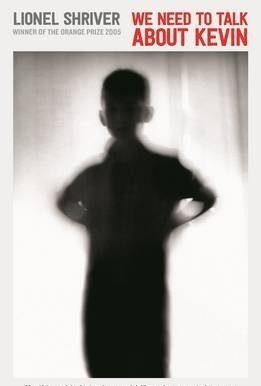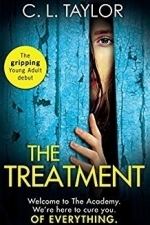Search
Search results
AmyBee (4 KP) rated We Need to Talk About Kevin in Books
Sep 5, 2018
WARNING - SPOILERS AHEAD!!! ALSO, THIS REVIEW IS STILL UNDER CONSTRUCTION SO IF PARTS DON'T MAKE SENSE, WORRY NOT, I'LL BE BACK TO FINISH IT LATER!
I quite liked this psychological family/crime drama although I did think it dragged on quite a bit with a LOT of unnecessary information. I understand that we are meant to be inside Eva's head, experiencing and feeling everything that she does/did but there is still a hell of a lot in there that could easily have been omitted with no harm to the rest of the story. On the other hand, this approach helps if we want to read the story like a 'stream of consciousness' style of narrative.
That said, it was still enjoyable if a little tedious at times due to my above point and I absolutely was not prepared for the ending!
Several people asked on Quora whether the younger sister harmed herself with the cleaning fluid on purpose, which made it very clear to me that some readers have fundamentally misunderstood the entire story, and this makes me wonder if they have a different view altogether on the ending - who do they see as being responsible for the murders? Kevin? Kevin's mother? Or, a combination of the actions of each character and toxic social/familial environments which ignored and subsequently exacerbated the poor mental health of several characters, encouraged cycles of abuse, revenge and retaliation. My guess is that they entirely and wrongly blame Kevin.
Shriver has written this novel very cleverly, as when we think about each character's transgressions out of context, we all know what is wrong and who is responsible; however this is written in such a way that it encourages the reader to pick a character to blame, providing arguments for and against each one along the way. In real life, this would never happen, as we do not get this kind of depth of insight into the lives of mass murderers. We simply blame the killer first and foremost, maybe looking briefly in disdain at his neglectful family.
In this novel, it isn't as easy to simply blame Kevin. He may be the killer, but there are so many more mitigating factors to consider.
His mother's narcissism makes her unable to see or accept her role in the actions of her very sick son. She sees him as "bad" and that's just not true. Even worse is that she treats him as though he is just bad rather than extremely ill.
I do wonder also, if the author got any backlash for writing this on the back of all the school shootings there has been in the US since the 1990's? Did people think this was an opportunistic move in the same way that they lambasted Emma whats-her-name for writing ROOM after the Josef Fritzl scandal?
I quite liked this psychological family/crime drama although I did think it dragged on quite a bit with a LOT of unnecessary information. I understand that we are meant to be inside Eva's head, experiencing and feeling everything that she does/did but there is still a hell of a lot in there that could easily have been omitted with no harm to the rest of the story. On the other hand, this approach helps if we want to read the story like a 'stream of consciousness' style of narrative.
That said, it was still enjoyable if a little tedious at times due to my above point and I absolutely was not prepared for the ending!
Several people asked on Quora whether the younger sister harmed herself with the cleaning fluid on purpose, which made it very clear to me that some readers have fundamentally misunderstood the entire story, and this makes me wonder if they have a different view altogether on the ending - who do they see as being responsible for the murders? Kevin? Kevin's mother? Or, a combination of the actions of each character and toxic social/familial environments which ignored and subsequently exacerbated the poor mental health of several characters, encouraged cycles of abuse, revenge and retaliation. My guess is that they entirely and wrongly blame Kevin.
Shriver has written this novel very cleverly, as when we think about each character's transgressions out of context, we all know what is wrong and who is responsible; however this is written in such a way that it encourages the reader to pick a character to blame, providing arguments for and against each one along the way. In real life, this would never happen, as we do not get this kind of depth of insight into the lives of mass murderers. We simply blame the killer first and foremost, maybe looking briefly in disdain at his neglectful family.
In this novel, it isn't as easy to simply blame Kevin. He may be the killer, but there are so many more mitigating factors to consider.
His mother's narcissism makes her unable to see or accept her role in the actions of her very sick son. She sees him as "bad" and that's just not true. Even worse is that she treats him as though he is just bad rather than extremely ill.
I do wonder also, if the author got any backlash for writing this on the back of all the school shootings there has been in the US since the 1990's? Did people think this was an opportunistic move in the same way that they lambasted Emma whats-her-name for writing ROOM after the Josef Fritzl scandal?
Hazel (1853 KP) rated Confidence in Books
Dec 17, 2018
<i>I received this book for free through Goodreads First Reads.</i>
Many university students will be able to relate to the panic and dread caused by dissertations and final exams. <i>Confidence</i>, co-written by Rowland Manthorpe and Kirstin Smith, is set at an English university where third year students are cramming in revision sessions in the lead up to their examinations. This story combines two character’s experiences which, although rarely overlap, reveal the effects of the lack of and over-confidence.
Whilst Ellie struggles with her dissertation, Charlie believes that he will successfully complete his degree without the need to revise, giving him more time to focus on his social (and sex) life. Both students are distracted by their less-than-perfect social lives, jeopardizing their exam results and discover that life is not at all what they predicted it to be.
<i>Confidence</i> is a book of multiple stories. Firstly (and secondly) there are Ellie’s and Charlie’s predicaments, but the remainder of the novel contains an autobiography of sorts about the nineteenth-century philosopher Friedrich Nietzsche – whom Ellie is penning her philosophy dissertation on. Whether these sections are an example of a student essay – are the authors aware that they are all written in the third person these days? – Nietzsche’s theories regarding confidence are highly relevant to the theme of the book.
The academically well-written sections about Nietzsche, his life and his spiral into insanity are very interesting to read. Composed in an essay-like format, the information is presented in an easy-to-understand, clear manner, making what in reality is a difficult concept to fathom, simple to comprehend. The fictional narrative, however, is much less pleasing in comparison. Filled with expletives, Manthorpe and Smith paint a stereotypical view of student life. Instead of the hard-working and dedicated people that many students are, they are depicted as alcoholic sex-maniacs.
Whilst negatively categorizing students, other issues are also raised such as feminism and mental health. Whereas these concerns are important topics in the twenty first century, the stigma and inaccurate knowledge about illnesses such as Anorexia is almost unforgivable – “[She] would grow out of it…” Seriously?!
As a story,<i> Confidence</i> falls well below my expectations. Although the stresses of university life are relatable, the characters go to extremes, making their scenarios all the more unrealistic. The essay on Nietzsche on the other hand is an enjoyable, informative piece of writing, which saves <i>Confidence</i> from the fate of a completely negative review. Perhaps my interest in philosophy helped me appreciate the depth of detail and knowledge written about Nietzsche, however I still maintain that it has been composed in such a way as to make it entertaining. Perhaps created with a student audience in mind, <i>Confidence</i> will most likely appeal to readers with the ability to think about the world from a philosophical perspective.
Many university students will be able to relate to the panic and dread caused by dissertations and final exams. <i>Confidence</i>, co-written by Rowland Manthorpe and Kirstin Smith, is set at an English university where third year students are cramming in revision sessions in the lead up to their examinations. This story combines two character’s experiences which, although rarely overlap, reveal the effects of the lack of and over-confidence.
Whilst Ellie struggles with her dissertation, Charlie believes that he will successfully complete his degree without the need to revise, giving him more time to focus on his social (and sex) life. Both students are distracted by their less-than-perfect social lives, jeopardizing their exam results and discover that life is not at all what they predicted it to be.
<i>Confidence</i> is a book of multiple stories. Firstly (and secondly) there are Ellie’s and Charlie’s predicaments, but the remainder of the novel contains an autobiography of sorts about the nineteenth-century philosopher Friedrich Nietzsche – whom Ellie is penning her philosophy dissertation on. Whether these sections are an example of a student essay – are the authors aware that they are all written in the third person these days? – Nietzsche’s theories regarding confidence are highly relevant to the theme of the book.
The academically well-written sections about Nietzsche, his life and his spiral into insanity are very interesting to read. Composed in an essay-like format, the information is presented in an easy-to-understand, clear manner, making what in reality is a difficult concept to fathom, simple to comprehend. The fictional narrative, however, is much less pleasing in comparison. Filled with expletives, Manthorpe and Smith paint a stereotypical view of student life. Instead of the hard-working and dedicated people that many students are, they are depicted as alcoholic sex-maniacs.
Whilst negatively categorizing students, other issues are also raised such as feminism and mental health. Whereas these concerns are important topics in the twenty first century, the stigma and inaccurate knowledge about illnesses such as Anorexia is almost unforgivable – “[She] would grow out of it…” Seriously?!
As a story,<i> Confidence</i> falls well below my expectations. Although the stresses of university life are relatable, the characters go to extremes, making their scenarios all the more unrealistic. The essay on Nietzsche on the other hand is an enjoyable, informative piece of writing, which saves <i>Confidence</i> from the fate of a completely negative review. Perhaps my interest in philosophy helped me appreciate the depth of detail and knowledge written about Nietzsche, however I still maintain that it has been composed in such a way as to make it entertaining. Perhaps created with a student audience in mind, <i>Confidence</i> will most likely appeal to readers with the ability to think about the world from a philosophical perspective.

HRV4Training
Health & Fitness and Sports
App
The only scientifically validated HRV app that doesn't require an external sensor. HRV4Training...

Holiday Destination by Nadine Shah
Album Watch
For most of us, 2016 was a tumultuous and ugly year - one steeped in political chaos and an air of...
rock pop

Deep Sleep and Relaxation Hypnosis- Cure Insomnia
Medical and Lifestyle
App
Does it work? 3.5 million people have used Mindifi's Deep Sleep and Relaxation hypnosis, a #1...
Hazel (1853 KP) rated The Treatment in Books
Sep 28, 2017
One Flew Over the Cuckoo's Nest for Teens
This ARC was provided by the publisher via NetGalley in exchange for an honest review
You have to help me. We’re not being reformed. We’re being brainwashed. When sixteen-year-old Drew Finch receives this note from a strange woman on the street claiming to be her brother’s psychologist, she does not know how to react. But when a speeding car hits the doctor immediately after, Drew begins to think something portentous is afoot. In The Treatment by C. L. Taylor, the Residential Reform Academy in Northumberland is achieving great things, turning antisocial teenagers into model citizens. Mason, Drew’s brother, has been expelled from three different schools and has been sent to the academy as a last resort, however, Drew now suspects that Mason is in trouble.
In a slightly dystopian setting, Drew, a usually quiet girl, easily gets herself admitted to the academy by punching the school bully. With the intention of helping Mason escape, Drew calmly arrives at the Academy, not realising how much danger she is placing herself in. She soon discovers that this would not be a transitory admission and, unless she escapes, she will become like all the other narcotised students.
Trying to remain fastidious whilst avoiding garrulous roommates and staff, Drew desperately tries to concoct an escape plan, however, she may be too late. The more she learns about the Residential Reform Academy, the more she discovers about the evil intentions behind it. How can she break out of the prison-like building and seek help when the government is deeply involved with the whole sordid procedure?
C. L. Taylor devises an exciting scenario that will appeal to fans of Cecelia Ahern’s Flawed and Kazuo Ishiguro’s Never Let Me Go. A thriller that needs a hero in the unlikely form of a teenage girl, The Treatment is a stimulating story about those without a public voice overthrowing the immoral experiments of the dastards in power.
A One Flew Over the Cuckoo’s Nest for teenagers, this book deals with themes of mental health, oppression and the misuse of authority. Told from the perspective of a girl who has been bullied most of her life and coming from a dysfunctional family, there is a lot for the reader to connect with. Although it does not allay the growing fears of governmental conspiracies, The Treatment ends with the positive message that by standing up to those who do you wrong has its rewards, not only for yourself but for those in similar situations too.
The Treatment is a very enjoyable book that pulls the reader into the story, causing them to question how they would handle a similar situation. Would they be as brave as Drew and her new friends, or would they be doomed to a fate of mindless obedience? Compelling from beginning to end, C. L. Taylor’s latest novel is a refreshing break from the over-the-top science fiction dystopian novels, preferring to tackle futuristic ideas that are much closer to home. This is a book that can be fully recommended to the Young Adult community.
You have to help me. We’re not being reformed. We’re being brainwashed. When sixteen-year-old Drew Finch receives this note from a strange woman on the street claiming to be her brother’s psychologist, she does not know how to react. But when a speeding car hits the doctor immediately after, Drew begins to think something portentous is afoot. In The Treatment by C. L. Taylor, the Residential Reform Academy in Northumberland is achieving great things, turning antisocial teenagers into model citizens. Mason, Drew’s brother, has been expelled from three different schools and has been sent to the academy as a last resort, however, Drew now suspects that Mason is in trouble.
In a slightly dystopian setting, Drew, a usually quiet girl, easily gets herself admitted to the academy by punching the school bully. With the intention of helping Mason escape, Drew calmly arrives at the Academy, not realising how much danger she is placing herself in. She soon discovers that this would not be a transitory admission and, unless she escapes, she will become like all the other narcotised students.
Trying to remain fastidious whilst avoiding garrulous roommates and staff, Drew desperately tries to concoct an escape plan, however, she may be too late. The more she learns about the Residential Reform Academy, the more she discovers about the evil intentions behind it. How can she break out of the prison-like building and seek help when the government is deeply involved with the whole sordid procedure?
C. L. Taylor devises an exciting scenario that will appeal to fans of Cecelia Ahern’s Flawed and Kazuo Ishiguro’s Never Let Me Go. A thriller that needs a hero in the unlikely form of a teenage girl, The Treatment is a stimulating story about those without a public voice overthrowing the immoral experiments of the dastards in power.
A One Flew Over the Cuckoo’s Nest for teenagers, this book deals with themes of mental health, oppression and the misuse of authority. Told from the perspective of a girl who has been bullied most of her life and coming from a dysfunctional family, there is a lot for the reader to connect with. Although it does not allay the growing fears of governmental conspiracies, The Treatment ends with the positive message that by standing up to those who do you wrong has its rewards, not only for yourself but for those in similar situations too.
The Treatment is a very enjoyable book that pulls the reader into the story, causing them to question how they would handle a similar situation. Would they be as brave as Drew and her new friends, or would they be doomed to a fate of mindless obedience? Compelling from beginning to end, C. L. Taylor’s latest novel is a refreshing break from the over-the-top science fiction dystopian novels, preferring to tackle futuristic ideas that are much closer to home. This is a book that can be fully recommended to the Young Adult community.
TheBookMother (105 KP) rated Unravelling Oliver in Books
May 17, 2019
It's as if Richard Hillman came back from the dead, you will not put it down.
I picked this little gem up on a supermarket fundraising bookshelf.
I was abit a dubious to begin with as it was quite short for a standard crime novel that I am normally used too at just 230 pages. I did worry it would be a rushed cliche but boy, was I wrong.
I have grown up on Midsummer Murders and Agatha Christie and it felt like a fresh voice on a classic crime thriller rather than the standard norm from Liz Nugent.
To everyone they seemed a happy and successful couple until one night Oliver beats his loving wife into a coma.
We are then thrown into a sad and neglected past, tragic events and secrets that have now suddenly caught up with Oliver.
The pace of the book is exquisite. Right from the first page you are thrown in to quite a dark act being commited leaving you with only one question.
Why did he do it?
The story is told from numerous character voices and POV each sharing their experiences and opinions of Oliver including Oliver himself each recounting past events right up until after the attack on Alice.
Each account over laps and we are taken back to summer in the 1970s on a French vineyard, growing up during that time in Ireland and the views of the time.
I enjoyed the that the themes of having a baby out of wedlock, grief, race, mental health, expectations, promiscuity and homosexuality were all present which really added to you imagining what the views were at the varying time periods covered throughout the book.
Hauntingly, the only person we do not hear from is Alice which adds to the tension as the outcome of the attack isn't mentioned until quite a way through the book.
Aside from the fact that you are introduced to Oliver committing a heinous act and brutally admitting that he expected more of a reaction for the first time he beat his wife he is not a likable character. You are waiting for it all to come crashing down around him and his 'privileged life' even after you find out about his past and as the it is unravelled, so is he. Think Richard Hillman from Coronation Street villain, someone you cannot help but resent.
Clever, dark and unexpected I couldn't put this down and consumed the lot in a day or so. The pace and easy readability of the book left me wanting to keep reading to a point of keeping the kids busy with a snack and Netflix while I could consume multiple chapters in the corner of the room!
It's just want I want in a crime novel; a good villain, a clever plot and a few twists along the way and an even more surprising ending which leaves you thinking perhaps there was a little bit of good in there after all?!
I was abit a dubious to begin with as it was quite short for a standard crime novel that I am normally used too at just 230 pages. I did worry it would be a rushed cliche but boy, was I wrong.
I have grown up on Midsummer Murders and Agatha Christie and it felt like a fresh voice on a classic crime thriller rather than the standard norm from Liz Nugent.
To everyone they seemed a happy and successful couple until one night Oliver beats his loving wife into a coma.
We are then thrown into a sad and neglected past, tragic events and secrets that have now suddenly caught up with Oliver.
The pace of the book is exquisite. Right from the first page you are thrown in to quite a dark act being commited leaving you with only one question.
Why did he do it?
The story is told from numerous character voices and POV each sharing their experiences and opinions of Oliver including Oliver himself each recounting past events right up until after the attack on Alice.
Each account over laps and we are taken back to summer in the 1970s on a French vineyard, growing up during that time in Ireland and the views of the time.
I enjoyed the that the themes of having a baby out of wedlock, grief, race, mental health, expectations, promiscuity and homosexuality were all present which really added to you imagining what the views were at the varying time periods covered throughout the book.
Hauntingly, the only person we do not hear from is Alice which adds to the tension as the outcome of the attack isn't mentioned until quite a way through the book.
Aside from the fact that you are introduced to Oliver committing a heinous act and brutally admitting that he expected more of a reaction for the first time he beat his wife he is not a likable character. You are waiting for it all to come crashing down around him and his 'privileged life' even after you find out about his past and as the it is unravelled, so is he. Think Richard Hillman from Coronation Street villain, someone you cannot help but resent.
Clever, dark and unexpected I couldn't put this down and consumed the lot in a day or so. The pace and easy readability of the book left me wanting to keep reading to a point of keeping the kids busy with a snack and Netflix while I could consume multiple chapters in the corner of the room!
It's just want I want in a crime novel; a good villain, a clever plot and a few twists along the way and an even more surprising ending which leaves you thinking perhaps there was a little bit of good in there after all?!
Heather Cranmer (2721 KP) rated Pretty Girl-13 in Books
Jun 7, 2018
(This review can be found on my blog <a href="http://themisadventuresofatwentysomething.blogspot.com/">The (Mis)Adventures of a Twenty-Something Year Old Girl</a> in September).
Pretty Girl-13 by Liz Coley was a book that I was dying to read. It was at the top of my TBR pile, so I was thrilled when I discovered that my local library had it. This turned out to be a fascinating read.
I'm not really a fan of the title. Yes, the main character is called Pretty Girl by her captor and at least one of her alters, but that's it. I, personally, think Gone Girl or some other title would've been better.
I do like the cover. I love how it shows Angie walking out of a cabin in the woods which ties in with the story. That cabin, as well as being real, is also symbolic.
I thought the author did an excellent job with making Angie's world come alive. Liz Coley wrote each alter well enough that they actually came across as being a different person with their own personality. The setting was fantastic too.
The pacing was fantastic! I pretty much breezed through this book in one day. It was held my attention the whole time, and I found it super interesting!
\I thought the plot of this book would mostly focus on Angie's kidnapping, but it focuses mainly on her Dissociative Identity Disorder. While we do learn about Angie's kidnapping and everything that happened, we learn it through each of her alters. The plot focuses on how Angie deals which each alter more than anything.
The characters are written very richly. Angie is a broken girl, and I ended up feeling like I wanted to protect her. There were some times when I felt really annoyed with her like when she wouldn't tell people certain key elements of what had happened to her. On one hand, I realize that she was kind of scared, but in one scene, she doesn't tell her mom something simply because she's angry at her. Now, all of this could probably be explained since she's been abused since she was 13, but it still just annoyed me. Overall, Angie is a great character. As I've said before, even her alters have personalities of her own, and the author does a great job at conveying that these alters are supposed to be their own person so to speak. Even the minor characters are done well such as Abraim. Abraim seemed like such a sweet guy and very accepting.
The dialogue was easy to understand although at some points, I felt as if Angie was older then 16. There is some swearing in this book if that's not your thing.
Overall, Pretty Girl-13 by Liz Coley is an enjoyable book. I found it fascinating to read about Dissociative Identity Disorder as well as trying to solve Angie's kidnapping.
I'd recommend this book to those aged 16+ (due to language and themes) who are interested in mental health as well as mysteries.
I'd give Pretty Girl-13 by Liz Coley a 4.5 out of 5.
Pretty Girl-13 by Liz Coley was a book that I was dying to read. It was at the top of my TBR pile, so I was thrilled when I discovered that my local library had it. This turned out to be a fascinating read.
I'm not really a fan of the title. Yes, the main character is called Pretty Girl by her captor and at least one of her alters, but that's it. I, personally, think Gone Girl or some other title would've been better.
I do like the cover. I love how it shows Angie walking out of a cabin in the woods which ties in with the story. That cabin, as well as being real, is also symbolic.
I thought the author did an excellent job with making Angie's world come alive. Liz Coley wrote each alter well enough that they actually came across as being a different person with their own personality. The setting was fantastic too.
The pacing was fantastic! I pretty much breezed through this book in one day. It was held my attention the whole time, and I found it super interesting!
\I thought the plot of this book would mostly focus on Angie's kidnapping, but it focuses mainly on her Dissociative Identity Disorder. While we do learn about Angie's kidnapping and everything that happened, we learn it through each of her alters. The plot focuses on how Angie deals which each alter more than anything.
The characters are written very richly. Angie is a broken girl, and I ended up feeling like I wanted to protect her. There were some times when I felt really annoyed with her like when she wouldn't tell people certain key elements of what had happened to her. On one hand, I realize that she was kind of scared, but in one scene, she doesn't tell her mom something simply because she's angry at her. Now, all of this could probably be explained since she's been abused since she was 13, but it still just annoyed me. Overall, Angie is a great character. As I've said before, even her alters have personalities of her own, and the author does a great job at conveying that these alters are supposed to be their own person so to speak. Even the minor characters are done well such as Abraim. Abraim seemed like such a sweet guy and very accepting.
The dialogue was easy to understand although at some points, I felt as if Angie was older then 16. There is some swearing in this book if that's not your thing.
Overall, Pretty Girl-13 by Liz Coley is an enjoyable book. I found it fascinating to read about Dissociative Identity Disorder as well as trying to solve Angie's kidnapping.
I'd recommend this book to those aged 16+ (due to language and themes) who are interested in mental health as well as mysteries.
I'd give Pretty Girl-13 by Liz Coley a 4.5 out of 5.
Heather Cranmer (2721 KP) rated A Man Derailed: An Autobiography on Depression in Books
Jun 7, 2018
(This review can also be found on my blog <a href="http://themisadventuresofatwentysomething.blogspot.co.uk">The (Mis)Adventures of a Twenty-Something Year Old Girl</a>).
As a sufferer of depression, this book definitely caught my attention. This synopsis for this book definitely drew me in, or perhaps I'm just nosy and want to know what it's like for others, lol. Either way, I was very impressed with this book.
A Man Derailed by Paul Holmes is one man's battle with depression due to a major life event. Holmes describes his battle with depression and his ups and downs. He also discusses what helped him get through his depression.
I just want to say that the title, A Man Derailed, is fantastic for this book. I definitely feel that this is a great title for the book due to what happens. I won't go into much more as I don't want to give anything away, but by the end of chapter 1, you will see why this title fits perfectly.
Being as this is an autobiography about one man's struggle with depression, I think the cover is well suited. I like how one side of Holmes' face is all black and the other is decorated in clown make-up. Having depression is like that. On one side, you feel like you're falling into a black abyss. On the other hand, you have to put on a facade to the world as mental health is still a very taboo subject, unfortunately.
Paul Holmes sets up the setting and world building of his book very well. Throughout the book, I felt I was seeing everything happen through his eyes as well as living it with him.
I'm not really a fan of autobiographies as most of the time, the pacing of the book is way too slow for my liking. However, A Man Derailed wasn't like that. The pacing of this book was spot on, and I found myself wanting to know more and more about what Mr. Holmes said or did.
I very much enjoyed how well written this book was. I loved how Holmes was able to inject humour into his book as well, so it wasn't all doom and gloom. A lot of the times, I was actually laughing out loud. I also found myself agreeing with everything Holmes had written. There is quite a bit of swearing, so if you're not big into swear words, be warned. However, I don't mind swearing as I think it totally fit in with the theme of this book. The only problem I found was that there were a lot of punctuation and grammar mistakes. However, this is because I'm a grammar nazi. It didn't really bother me, nor did it take away from the book.
I'd recommend this book to everyone aged 16+ that have/had depression, that know someone with depression, or those who want to have more insight into what it's like having depression.
I'd give A Man Derailed by Paul Holmes a 4.5 out of 5.
As a sufferer of depression, this book definitely caught my attention. This synopsis for this book definitely drew me in, or perhaps I'm just nosy and want to know what it's like for others, lol. Either way, I was very impressed with this book.
A Man Derailed by Paul Holmes is one man's battle with depression due to a major life event. Holmes describes his battle with depression and his ups and downs. He also discusses what helped him get through his depression.
I just want to say that the title, A Man Derailed, is fantastic for this book. I definitely feel that this is a great title for the book due to what happens. I won't go into much more as I don't want to give anything away, but by the end of chapter 1, you will see why this title fits perfectly.
Being as this is an autobiography about one man's struggle with depression, I think the cover is well suited. I like how one side of Holmes' face is all black and the other is decorated in clown make-up. Having depression is like that. On one side, you feel like you're falling into a black abyss. On the other hand, you have to put on a facade to the world as mental health is still a very taboo subject, unfortunately.
Paul Holmes sets up the setting and world building of his book very well. Throughout the book, I felt I was seeing everything happen through his eyes as well as living it with him.
I'm not really a fan of autobiographies as most of the time, the pacing of the book is way too slow for my liking. However, A Man Derailed wasn't like that. The pacing of this book was spot on, and I found myself wanting to know more and more about what Mr. Holmes said or did.
I very much enjoyed how well written this book was. I loved how Holmes was able to inject humour into his book as well, so it wasn't all doom and gloom. A lot of the times, I was actually laughing out loud. I also found myself agreeing with everything Holmes had written. There is quite a bit of swearing, so if you're not big into swear words, be warned. However, I don't mind swearing as I think it totally fit in with the theme of this book. The only problem I found was that there were a lot of punctuation and grammar mistakes. However, this is because I'm a grammar nazi. It didn't really bother me, nor did it take away from the book.
I'd recommend this book to everyone aged 16+ that have/had depression, that know someone with depression, or those who want to have more insight into what it's like having depression.
I'd give A Man Derailed by Paul Holmes a 4.5 out of 5.




